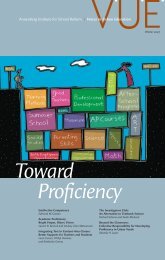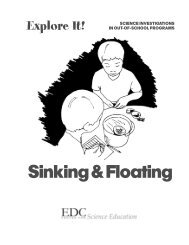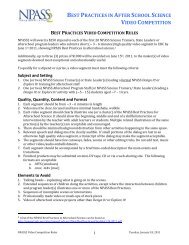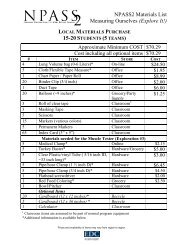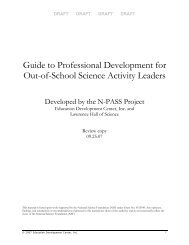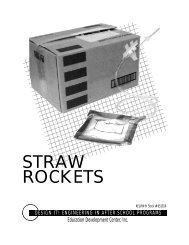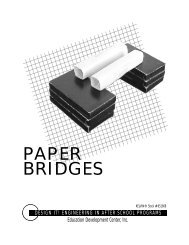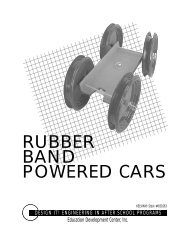4 - NPASS2 - Education Development Center, Inc.
4 - NPASS2 - Education Development Center, Inc.
4 - NPASS2 - Education Development Center, Inc.
Create successful ePaper yourself
Turn your PDF publications into a flip-book with our unique Google optimized e-Paper software.
MARYLAND <strong>NPASS2</strong> SCIENCE<br />
TRAINERS INSTITUTE<br />
TASI, Baltimore, MD<br />
January 20 th – 22 nd , 2010<br />
A project of the <strong>Center</strong> for Science <strong>Education</strong> at EDC <strong>Inc</strong>,<br />
Funded by the National Science Foundation NSF # 0917576<br />
Copyright © 2008 <strong>Education</strong> <strong>Development</strong> <strong>Center</strong>, <strong>Inc</strong>.<br />
http://cse.edc.org/
<strong>NPASS2</strong> Science<br />
Trainer Teams<br />
Minnesota<br />
New Hampshire<br />
California<br />
Missouri<br />
Ohio<br />
Maryland<br />
New<br />
Jersey<br />
Georgia<br />
Copyright © 2008 <strong>Education</strong> <strong>Development</strong> <strong>Center</strong>, <strong>Inc</strong>.<br />
http://cse.edc.org/
<strong>NPASS2</strong> Mission<br />
Prepare the OST field to deliver<br />
science programming that engages<br />
children from populations/groups<br />
that are under represented in<br />
STEM study/careers in regular<br />
science exploration that builds their<br />
interest and confidence to pursue<br />
formal study and/or careers in<br />
STEM fields<br />
Copyright © 2008 <strong>Education</strong> <strong>Development</strong> <strong>Center</strong>, <strong>Inc</strong>.<br />
http://cse.edc.org/
<strong>NPASS2</strong> Objectives<br />
Promote appropriate, project-based<br />
science learning as an integral element of<br />
OST for under served children and youth<br />
Strengthen the ability of state OST<br />
networks to promote and fund high-quality<br />
science programming<br />
Prepare and support a new cadre of<br />
Science Trainers to serve the OST field<br />
Copyright © 2008 <strong>Education</strong> <strong>Development</strong> <strong>Center</strong>, <strong>Inc</strong>.<br />
http://cse.edc.org/
% of US 4 th and 8 th<br />
graders proficient in<br />
science. (NAEP 2005)<br />
29<br />
Copyright © 2008 <strong>Education</strong> <strong>Development</strong> <strong>Center</strong>, <strong>Inc</strong>.<br />
http://cse.edc.org/
% of US 12 th graders,<br />
proficient in science.<br />
18<br />
Copyright © 2008 <strong>Education</strong> <strong>Development</strong> <strong>Center</strong>, <strong>Inc</strong>.<br />
http://cse.edc.org/
% increase between 1998<br />
and 2008 in the number of<br />
US jobs requiring training<br />
in STEM<br />
51<br />
Copyright © 2008 <strong>Education</strong> <strong>Development</strong> <strong>Center</strong>, <strong>Inc</strong>.<br />
http://cse.edc.org/
% by which this is<br />
faster than the overall<br />
job growth in the overall<br />
US economy<br />
400<br />
Copyright © 2008 <strong>Education</strong> <strong>Development</strong> <strong>Center</strong>, <strong>Inc</strong>.<br />
http://cse.edc.org/
% of HS graduates aged<br />
25 – 29 (2000) with<br />
bachelor’s or higher<br />
degrees in science<br />
• Whites 36<br />
• African Americans 21<br />
• Hispanics 15<br />
Copyright © 2008 <strong>Education</strong> <strong>Development</strong> <strong>Center</strong>, <strong>Inc</strong>.<br />
http://cse.edc.org/
% of women in the US<br />
workforce.<br />
45<br />
Copyright © 2008 <strong>Education</strong> <strong>Development</strong> <strong>Center</strong>, <strong>Inc</strong>.<br />
http://cse.edc.org/
% of science and<br />
engineering jobs in<br />
business and industry<br />
held by women<br />
12<br />
Copyright © 2008 <strong>Education</strong> <strong>Development</strong> <strong>Center</strong>, <strong>Inc</strong>.<br />
http://cse.edc.org/
Factor that predicts better<br />
than test performance which<br />
eighth-grade students will<br />
pursue careers in science<br />
Interest in science careers<br />
Copyright © 2008 <strong>Education</strong> <strong>Development</strong> <strong>Center</strong>, <strong>Inc</strong>.<br />
http://cse.edc.org/
The Agenda for this<br />
Institute<br />
• Day 1 Balls & Tracks: Exploring an<br />
engineering/design project as learners<br />
• Day 2 Spinning Toys: Considering the<br />
skills and competencies required to<br />
lead such a project with children<br />
• Day 3 Paper Bridges: Preparing to<br />
train others to lead these projects with<br />
children<br />
Copyright © 2008 <strong>Education</strong> <strong>Development</strong> <strong>Center</strong>, <strong>Inc</strong>.<br />
http://cse.edc.org/
How Children really make<br />
sense of the World …<br />
…a story<br />
“<strong>Inc</strong>hworms made God…”<br />
Oliver (Age 5)
Balls & Tracks<br />
Design-It!<br />
Copyright © 2008 <strong>Education</strong> <strong>Development</strong> <strong>Center</strong>, <strong>Inc</strong>.<br />
http://cse.edc.org/
Challenge #1<br />
Ski Jump<br />
Make your marble JUMP/FLY into the<br />
can/cup<br />
What is the farthest your marble can<br />
jump/fly (first bounce?)<br />
Copyright © 2008 <strong>Education</strong> <strong>Development</strong> <strong>Center</strong>, <strong>Inc</strong>.<br />
MATERIALS<br />
• 1 x 6’ Foam tube<br />
• Marbles<br />
• Can/Cup<br />
• Tape (not too much)<br />
• Tape measure<br />
http://cse.edc.org/
Challenge #2: Hills and Valleys<br />
<br />
Make a Track with lots of hills and<br />
valleys. How many hills can you have<br />
with these materials?<br />
Can a high hill follow a low one?<br />
MATERIALS<br />
• 2 x 6’ Foam tubes<br />
• Marbles<br />
• Tape (not too much)<br />
• Tape measure<br />
Copyright © 2008 <strong>Education</strong> <strong>Development</strong> <strong>Center</strong>, <strong>Inc</strong>.<br />
http://cse.edc.org/
Challenge #3: Loops and<br />
Spirals<br />
Add loops and spirals to make a<br />
Roller Coaster that is as EXCITING<br />
as you can make it.<br />
MATERIALS<br />
• 3 x 6’ Foam tubes<br />
• Marbles<br />
• Tape (not too much)<br />
• Tape measure<br />
Copyright © 2008 <strong>Education</strong> <strong>Development</strong> <strong>Center</strong>, <strong>Inc</strong>.<br />
http://cse.edc.org/
Challenge #4: Obstacle<br />
Course<br />
Add Obstacles to your Rollercoaster<br />
– gaps, tunnels, knots, leaps of death!<br />
MATERIALS<br />
• 3 x 6’ Foam tubes<br />
• Marbles<br />
• Tape (not too much)<br />
• Tape measure<br />
Copyright © 2008 <strong>Education</strong> <strong>Development</strong> <strong>Center</strong>, <strong>Inc</strong>.<br />
http://cse.edc.org/
Maryland NPASS Science<br />
Trainers Institute: Day 2<br />
Copyright © 2008 <strong>Education</strong> <strong>Development</strong> <strong>Center</strong>, <strong>Inc</strong>.<br />
http://cse.edc.org/
NPASS Science<br />
projects are….<br />
• Extended investigations and challenges<br />
with simple materials<br />
• Foundational experience/learning with<br />
interesting materials and phenomena<br />
• Collaborative problem solving and<br />
learning experiences<br />
• Focused on Process Skills and Sense<br />
Making<br />
Copyright © 2008 <strong>Education</strong> <strong>Development</strong> <strong>Center</strong>, <strong>Inc</strong>.<br />
http://cse.edc.org/
NPASS Curriculum<br />
Projects Feature<br />
• Direct Experiences with Phenomenon<br />
• Simple (transparent) Materials<br />
• Engaging, Accessible Topics<br />
• Extended Explorations, Design<br />
Challenges, Problem solving<br />
• Time and Suggestions for Reflection<br />
and Meaning-making<br />
Copyright © 2008 <strong>Education</strong> <strong>Development</strong> <strong>Center</strong>, <strong>Inc</strong>.<br />
http://cse.edc.org/
Process Skills for<br />
Afterschool Science<br />
• Observing<br />
• Investigating<br />
• Questioning<br />
• Explaining<br />
Copyright © 2008 <strong>Education</strong> <strong>Development</strong> <strong>Center</strong>, <strong>Inc</strong>.<br />
http://cse.edc.org/
EDC 1958 - 2008<br />
NEWTON<br />
New York<br />
Washington, DC<br />
The Netherlands (EDC Europe)<br />
Around the Globe . . .<br />
Newport, RI<br />
Thailand<br />
Guinea<br />
Haiti<br />
Egypt<br />
Mali<br />
Tanzania<br />
Ghana<br />
Copyright © 2008 <strong>Education</strong> <strong>Development</strong> <strong>Center</strong>, <strong>Inc</strong>.<br />
http://cse.edc.org/
Math Science Programs (Unit)<br />
[Formerly the <strong>Center</strong> for Science <strong>Education</strong>]<br />
• Technical Assistance<br />
• Curriculum <strong>Development</strong><br />
• Research and Evaluation<br />
• Professional <strong>Development</strong><br />
Copyright © 2008 <strong>Education</strong> <strong>Development</strong> <strong>Center</strong>, <strong>Inc</strong>.<br />
http://cse.edc.org/
A Brief History of Science<br />
Teaching: Children learn<br />
science when they …<br />
• Read and Listen (text, lecture)<br />
• Watch, Follow Directions (demonstrations,<br />
labs)<br />
• Explore materials directly (hands-on)<br />
• Perform Experiments, Collect Evidence<br />
• Reflect, Discuss Meaning and<br />
Significance<br />
Copyright © 2008 <strong>Education</strong> <strong>Development</strong> <strong>Center</strong>, <strong>Inc</strong>.<br />
http://cse.edc.org/
Early Childhood<br />
1966<br />
1964<br />
2004<br />
1964<br />
2003 2003<br />
Copyright © 2008 <strong>Education</strong> <strong>Development</strong> <strong>Center</strong>, <strong>Inc</strong>.<br />
http://cse.edc.org/
Elementary<br />
1995<br />
1970<br />
1967<br />
Copyright © 2008 <strong>Education</strong> <strong>Development</strong> <strong>Center</strong>, <strong>Inc</strong>.<br />
1970<br />
http://cse.edc.org/<br />
1969<br />
1990/1994/2003
Out of School<br />
2005<br />
2005<br />
2001<br />
Copyright © 2008 <strong>Education</strong> <strong>Development</strong> <strong>Center</strong>, <strong>Inc</strong>.<br />
http://cse.edc.org/
The Design-It! Succession<br />
• Design-It! 1999 – 2002<br />
• Explore-It! 2002 – 2005<br />
• NPASS 2005 – 2010<br />
• <strong>NPASS2</strong> 2009 – 2012<br />
Copyright © 2008 <strong>Education</strong> <strong>Development</strong> <strong>Center</strong>, <strong>Inc</strong>.<br />
http://cse.edc.org/
Spinning Toys:<br />
Design-It!<br />
Copyright © 2008 <strong>Education</strong> <strong>Development</strong> <strong>Center</strong>, <strong>Inc</strong>.<br />
http://cse.edc.org/
TOPS # 1: Make a Top<br />
Make a TOP out of any of these materials<br />
Make it spin for at least 8 seconds<br />
MATERIALS<br />
• 1 Heavy Paper Plate<br />
• I dowel<br />
• I pencil<br />
• 2 Rubber Bumpers<br />
• 2 Binder clips<br />
Copyright © 2008 <strong>Education</strong> <strong>Development</strong> <strong>Center</strong>, <strong>Inc</strong>.<br />
http://cse.edc.org/
TOPS # 2: Weight<br />
and Width<br />
Make a new TOP with these extra materials<br />
Can you make it spin for 60 seconds<br />
Can you make a string launcher<br />
MATERIALS<br />
• 4 - 6 Heavy Paper Plates, various sizes<br />
• I dowel, pencil<br />
• 2 Rubber Bumpers<br />
• 2 Binder clips<br />
• String and index card<br />
Copyright © 2008 <strong>Education</strong> <strong>Development</strong> <strong>Center</strong>, <strong>Inc</strong>.<br />
http://cse.edc.org/
Spinning Toys:<br />
TOPS # 3<br />
Make a TOP with ANY materials<br />
Can you make it spin for 2 minutes<br />
MATERIALS<br />
• Heavy Paper Plates<br />
• Frisbees, Old Records, Lazy Susan<br />
• Pencils, Bolts, Chopsticks, dowel<br />
• Rubber Bumpers, Binder clips, tape, hot<br />
glue, string<br />
Copyright © 2008 <strong>Education</strong> <strong>Development</strong> <strong>Center</strong>, <strong>Inc</strong>.<br />
http://cse.edc.org/
Spinning Toys # 4:<br />
Yo-Yos<br />
Make a Yo-Yo with these materials<br />
Can you make it spin back up to your<br />
hand<br />
MATERIALS<br />
• 2 Heavy Paper Plates<br />
• I dowel<br />
• 1 wooden spool<br />
• Cotton string (30 inches)<br />
• 2 Rubber Bumpers<br />
Copyright © 2008 <strong>Education</strong> <strong>Development</strong> <strong>Center</strong>, <strong>Inc</strong>.<br />
http://cse.edc.org/
Spinning Toys # 5:<br />
Testing your Yo-Yo<br />
Test the effect of weight and diameter on<br />
how the Yo-Yo spins<br />
MATERIALS<br />
• Heavy Paper Plates, various sizes<br />
• I dowel<br />
• 1 wooden spool<br />
• Cotton string (36 inches)<br />
• 2 Rubber Bumpers<br />
Copyright © 2008 <strong>Education</strong> <strong>Development</strong> <strong>Center</strong>, <strong>Inc</strong>.<br />
http://cse.edc.org/
Spinning Toys # 6:<br />
Can-Can Yo-Yo<br />
Make a Can- Can Yo-Yo<br />
Walk the dog???<br />
MATERIALS<br />
• 2 Tuna or cat food cans<br />
• ¼ inch threaded bolt, x 3 inches long<br />
• Wing nut and washers<br />
• 1 wooden spool or rigid plastic tube<br />
• Cotton string (36 inches)<br />
Copyright © 2008 <strong>Education</strong> <strong>Development</strong> <strong>Center</strong>, <strong>Inc</strong>.<br />
http://cse.edc.org/
Who’s Working in OST<br />
• What skills/assets do they<br />
bring?<br />
• What challenges do they face?<br />
• What support do they need?<br />
Copyright © 2008 <strong>Education</strong> <strong>Development</strong> <strong>Center</strong>, <strong>Inc</strong>.<br />
http://cse.edc.org/
Teaching Skills for<br />
After School Science<br />
Noe Hinijos<br />
King Open School,<br />
Cambridge, Mass.
Teaching Competencies<br />
for OST Science<br />
• Preparation – reading the guide<br />
• Materials Management<br />
• Introduction: Setting the Context<br />
• Pacing – working the floor<br />
• Engaging with the Children<br />
• Modeling Process Skills<br />
• Leading Discussions<br />
• Closure<br />
Copyright © 2008 <strong>Education</strong> <strong>Development</strong> <strong>Center</strong>, <strong>Inc</strong>.<br />
http://cse.edc.org/
The NPASS Training<br />
Model<br />
Copyright © 2008 <strong>Education</strong> <strong>Development</strong> <strong>Center</strong>, <strong>Inc</strong>.<br />
http://cse.edc.org/
<strong>NPASS2</strong> Levels of<br />
Participation<br />
• <strong>Center</strong> for Science Ed (EDC)<br />
• External Evaluators (GRG)<br />
• State Leaders (8 states)<br />
• Science Trainers - ~10/state<br />
• Program sites - ~5/Trainer<br />
• Children ~15/site<br />
Copyright © 2008 <strong>Education</strong> <strong>Development</strong> <strong>Center</strong>, <strong>Inc</strong>.<br />
http://cse.edc.org/
<strong>NPASS2</strong> Trainers<br />
Scope of Work<br />
NPASS Science Trainers agree<br />
to comply (to the extent possible)<br />
with the <strong>NPASS2</strong> Science<br />
Trainers Scope of Work and with<br />
the details of the Training Model<br />
demonstrated in this Institute<br />
Copyright © 2008 <strong>Education</strong> <strong>Development</strong> <strong>Center</strong>, <strong>Inc</strong>.<br />
http://cse.edc.org/
Monthly Training Regimen<br />
• Trainers each leads 6 formal,<br />
(~monthly) workshops/year for<br />
~ 5 CBO’s – as a group<br />
• Workshops last ~ 3 hours<br />
• Each workshop prepares CBO’s to<br />
lead ONE new project with children<br />
• CBO’s receive a kit at each training<br />
Copyright © 2008 <strong>Education</strong> <strong>Development</strong> <strong>Center</strong>, <strong>Inc</strong>.<br />
http://cse.edc.org/
Some Finer Points of the<br />
Monthly Trainings<br />
• Trainers model how to lead the<br />
projects with children<br />
• Initial focus is on successful<br />
implementation of each project<br />
• Gradual increased attention to<br />
Teaching/Learning skills and styles<br />
• Create a Community of Learners<br />
among the Program Leaders<br />
Copyright © 2008 <strong>Education</strong> <strong>Development</strong> <strong>Center</strong>, <strong>Inc</strong>.<br />
http://cse.edc.org/
Factors For Success<br />
• OST sites that are READY!<br />
• Administrator buy-in (attend trainings)<br />
• Critical mass of participants – guests<br />
• Stick to the agenda and schedule<br />
• Encourage a community of practice<br />
• Make sure OST staff have fun (ahah<br />
moments) too. We can’t skip a<br />
generation.<br />
Copyright © 2008 <strong>Education</strong> <strong>Development</strong> <strong>Center</strong>, <strong>Inc</strong>.<br />
http://cse.edc.org/
Avoid…<br />
• Indirect/informal (2 nd hand)<br />
Training<br />
• CBO’s gathering materials<br />
• Drop-in by kids<br />
• Too many/few kids<br />
Copyright © 2008 <strong>Education</strong> <strong>Development</strong> <strong>Center</strong>, <strong>Inc</strong>.<br />
http://cse.edc.org/
Maryland Science Trainers<br />
Institute: Day 3<br />
Copyright © 2008 <strong>Education</strong> <strong>Development</strong> <strong>Center</strong>, <strong>Inc</strong>.<br />
http://cse.edc.org/
Theory of Change #1<br />
Engaging and well-led OST<br />
STEM projects can build<br />
children’s science skills and also<br />
build their confidence that they<br />
have capacity to participate in<br />
STEM study and careers.<br />
Copyright © 2008 <strong>Education</strong> <strong>Development</strong> <strong>Center</strong>, <strong>Inc</strong>.<br />
http://cse.edc.org/
Theory of Change #2<br />
Front line OST staff with little prior<br />
experience or confidence in<br />
STEM, who receive well crafted<br />
and ongoing training and support<br />
can lead high quality STEM<br />
projects with children well<br />
Copyright © 2008 <strong>Education</strong> <strong>Development</strong> <strong>Center</strong>, <strong>Inc</strong>.<br />
http://cse.edc.org/
Theory of Change #3<br />
A well prepared state-based cadre<br />
of OST Science Trainers and a<br />
resourceful and committed state<br />
OST infrastructure are crucial to<br />
the widespread improvement in<br />
the quality and quantity of<br />
Science Programming in OST<br />
Copyright © 2008 <strong>Education</strong> <strong>Development</strong> <strong>Center</strong>, <strong>Inc</strong>.<br />
http://cse.edc.org/
Things that Work: Trainers<br />
• Trainers who know OST (domain/sites)<br />
• Get to know Site Administrators (invite them to<br />
attend Trainings too)<br />
• Regular training format (central, monthly, ~3 hrs).<br />
• Consistent curriculum type. ONE at a time.<br />
• Early focus on successful implementation.<br />
• Gradual shift towards pedagogy.<br />
• Model what you want modeled (best practice)<br />
• Build OST capacity<br />
• Build community of practice<br />
Copyright © 2008 <strong>Education</strong> <strong>Development</strong> <strong>Center</strong>, <strong>Inc</strong>.<br />
http://cse.edc.org/
Things that Work: CBO’s<br />
• 1 year + commitment (Administrator<br />
signs Letter of Agreement)<br />
• Dedicated “science” program leader<br />
• Paid attendance at workshops (staff)<br />
• Dedicated/separate activity space.<br />
Storage space<br />
• Regular programming – ONCE/wk+<br />
• Consistent group of children (“club”)<br />
Copyright © 2008 <strong>Education</strong> <strong>Development</strong> <strong>Center</strong>, <strong>Inc</strong>.<br />
http://cse.edc.org/
Plan your First Workshop<br />
• Write an Agenda on a sheet of Poster<br />
paper<br />
• Start at 9:00 AM<br />
• End at 12:00 PM<br />
• Note the start times of each major<br />
activity you plan during the workshop.<br />
Copyright © 2008 <strong>Education</strong> <strong>Development</strong> <strong>Center</strong>, <strong>Inc</strong>.<br />
http://cse.edc.org/
Paper Bridges<br />
Design-It!<br />
Copyright © 2008 <strong>Education</strong> <strong>Development</strong> <strong>Center</strong>, <strong>Inc</strong>.<br />
http://cse.edc.org/
Challenge #1: Invent a Bridge<br />
Make a Bridge over an 8½ inch River using<br />
just 4 sheets of paper.<br />
Make the bridge as strong as you can. It<br />
must not be taped or fixed to the river banks<br />
MATERIALS<br />
• 4 sheets 8½ x 11 paper<br />
• “River Banks” (Books or boxes)<br />
• Metal Washers<br />
• Paper Cup and Cardboard Square<br />
• Elastic Bands (just a few)<br />
• Tape (just a little)<br />
Copyright © 2008 <strong>Education</strong> <strong>Development</strong> <strong>Center</strong>, <strong>Inc</strong>.<br />
http://cse.edc.org/
Challenge #2: Rolled Beams<br />
Use rolled beams to make a Bridge over<br />
an 8½ inch river using just 4 sheets of paper.<br />
Use rolled beams to make a Bridge over<br />
an 11 inches river using just 6 sheets of<br />
paper<br />
MATERIALS<br />
• 6 sheets 8½ x 11 paper<br />
• “River Banks” (Books or boxes)<br />
• Metal Washers, Water Bottles, etc<br />
• Paper Cup and Cardboard Square<br />
• Elastic bands (just a few)<br />
• Tape (just a little)<br />
Copyright © 2008 <strong>Education</strong> <strong>Development</strong> <strong>Center</strong>, <strong>Inc</strong>.<br />
http://cse.edc.org/
Challenge #3:<br />
Accordion Beams<br />
Use accordion beams to make a Bridge<br />
over an 8½ inch river using just 4 sheets of<br />
paper or an 11 inches river using just 6<br />
sheets of paper<br />
MATERIALS<br />
• 6 sheets 8½ x 11 paper<br />
• Metal Washers, Water Bottles, etc<br />
• Paper Cup and Cardboard Square<br />
• Elastic bands (just a few)<br />
• Tape (not too much)<br />
Copyright © 2008 <strong>Education</strong> <strong>Development</strong> <strong>Center</strong>, <strong>Inc</strong>.<br />
http://cse.edc.org/
Challenge #4: Columns<br />
Make a structure that is 4¼ inches high<br />
using just 4 sheets of paper<br />
Test the maximum load this structure can<br />
carry<br />
MATERIALS<br />
• 4 sheets 8½ x 11 paper<br />
• Metal Washers, Water Bottles, etc<br />
• Paper Cup and Cardboard Square<br />
• Elastic bands (just a few)<br />
• Tape (not too much)<br />
Copyright © 2008 <strong>Education</strong> <strong>Development</strong> <strong>Center</strong>, <strong>Inc</strong>.<br />
http://cse.edc.org/
Challenge #4b:<br />
Super Columns<br />
Make a three-tiered structure with levels at<br />
least 4¼ inches apart using 4 sheets of paper<br />
or less on each level<br />
Load the structure with 1 gallon of water<br />
MATERIALS<br />
• 8½ x 11 paper<br />
• 1 gallon Water Bottle, full<br />
• Cardboard Squares<br />
• Elastic bands, Tape (not too much)<br />
Copyright © 2008 <strong>Education</strong> <strong>Development</strong> <strong>Center</strong>, <strong>Inc</strong>.<br />
http://cse.edc.org/
Challenge #5:<br />
Bridges with Columns<br />
Make a Bridge that spans at least 22<br />
inches. Build Columns or Piers to support the<br />
center of the bridge<br />
What is the greatest load that can drive<br />
across the whole the structure.<br />
MATERIALS<br />
• 8½ x 11 paper<br />
• Metal Washers, Water Bottles, etc<br />
• 3 Cardboard Squares<br />
• Tape, Elastic Bands (not too much)<br />
Copyright © 2008 <strong>Education</strong> <strong>Development</strong> <strong>Center</strong>, <strong>Inc</strong>.<br />
http://cse.edc.org/
<strong>NPASS2</strong> Evaluation<br />
Training Institute<br />
Goodman Research Group, <strong>Inc</strong>.
Introduction to External Evaluator<br />
• Goodman Research Group, <strong>Inc</strong>.<br />
– Located in Cambridge, Massachusetts<br />
– Over 20 years of experience in program<br />
evaluation<br />
– Evaluated NPASS1<br />
Goodman Research Group, <strong>Inc</strong>.
NPASS1 Evaluation Findings<br />
• The NPASS1 project met its goals for impact:<br />
– Consistent group of 11 training organization<br />
– 50 community-based organizations (CBO’s)<br />
– CBO’s adopted NPASS and expected to continue<br />
– The project’s 3-tiered model worked well<br />
– Training was effective for all involved:<br />
• <strong>Inc</strong>reased confidence<br />
• Valued OST professional development<br />
Goodman Research Group, <strong>Inc</strong>.
<strong>NPASS2</strong> Goals<br />
• For OST settings<br />
– Improve quality and quantity of science programming<br />
(especially for underserved children)<br />
– Improve OST workers’ science confidence and competence<br />
• For states and wider OST network<br />
– Create new level of expertise in OST field – OST Science<br />
Trainer<br />
– Strengthen OST network’s ability to promote/fund highquality<br />
science programming<br />
– Promote project-based science learning as integral element<br />
of OST<br />
Goodman Research Group, <strong>Inc</strong>.
Importance of <strong>NPASS2</strong> Evaluation<br />
• Will assist all of us in learning what is<br />
working and what isn’t – and will help with<br />
key decisions<br />
• Could assist in obtaining additional funds for<br />
related work<br />
• Provides accountability to NSF<br />
Goodman Research Group, <strong>Inc</strong>.
Evaluation Research Topics<br />
<br />
<br />
Impact in informal science education/outreach<br />
• State Administrators and the state<br />
• OST Science Trainers<br />
• OST Site Administrators<br />
• OST Youth Workers<br />
Implementation<br />
• STEM programming at participating sites<br />
• Project implementation issues at any level<br />
67
Evaluation Methods<br />
Science Trainers<br />
<br />
<br />
Three web-based surveys over the three years<br />
Assist in tracking program participation on ongoing basis<br />
Others in <strong>NPASS2</strong><br />
<br />
Youth Workers, Site Administrators: 1 web-based survey<br />
<br />
State Leaders: 3 surveys, other possible data collection<br />
68<br />
<br />
Attendance by evaluators at some training sessions
GRG will …<br />
• Give you advance notice of research<br />
activities<br />
• Schedule contacts at your convenience and<br />
without getting in the way of the program<br />
• Provide reasonable amount of time to<br />
respond to requests for information<br />
• Request only relevant data<br />
Goodman Research Group, <strong>Inc</strong>.
GRG asks that you …<br />
• Respond to requests within time-frames<br />
given<br />
• Complete surveys/forms as completely as<br />
possible<br />
• Convey your support for the evaluation to<br />
others (e.g., your science trainers)<br />
Goodman Research Group, <strong>Inc</strong>.
Coming up …<br />
• Initial Science Trainer Survey<br />
– Expect email from Laura at GRG after Institute<br />
– Email will contain link to on-line survey and password<br />
– Survey will gather background information and feedback on<br />
Institute<br />
– Your responses will be confidential<br />
• Regular program tracking form<br />
(paper or electronic – it’s up to you!)<br />
– Complete it at the end of every program you field<br />
– Send it immediately to your State Leader contact<br />
Goodman Research Group, <strong>Inc</strong>.
Goodman Research Group, <strong>Inc</strong>.<br />
955 Massachusetts Avenue, Suite 201<br />
Cambridge, MA 02139<br />
Tel: (617) 491-7033<br />
Fax: (617) 864-2399<br />
www.grginc.com<br />
Questions? Contact Laura Houseman at<br />
houseman@grginc.com<br />
Goodman Research Group, <strong>Inc</strong>.
OST Science Can Provide<br />
Three Levels of Support<br />
Activities that<br />
Engage and<br />
A Culture of<br />
Achievement<br />
Motivate<br />
Mastery of<br />
Skills that<br />
Matter<br />
Copyright © 2008 <strong>Education</strong> <strong>Development</strong> <strong>Center</strong>, <strong>Inc</strong>.<br />
http://cse.edc.org/
Copyright © 2008 <strong>Education</strong> <strong>Development</strong> <strong>Center</strong>, <strong>Inc</strong>.<br />
http://cse.edc.org/
<strong>NPASS2</strong> Website<br />
http://npass2.ed<br />
c.org




